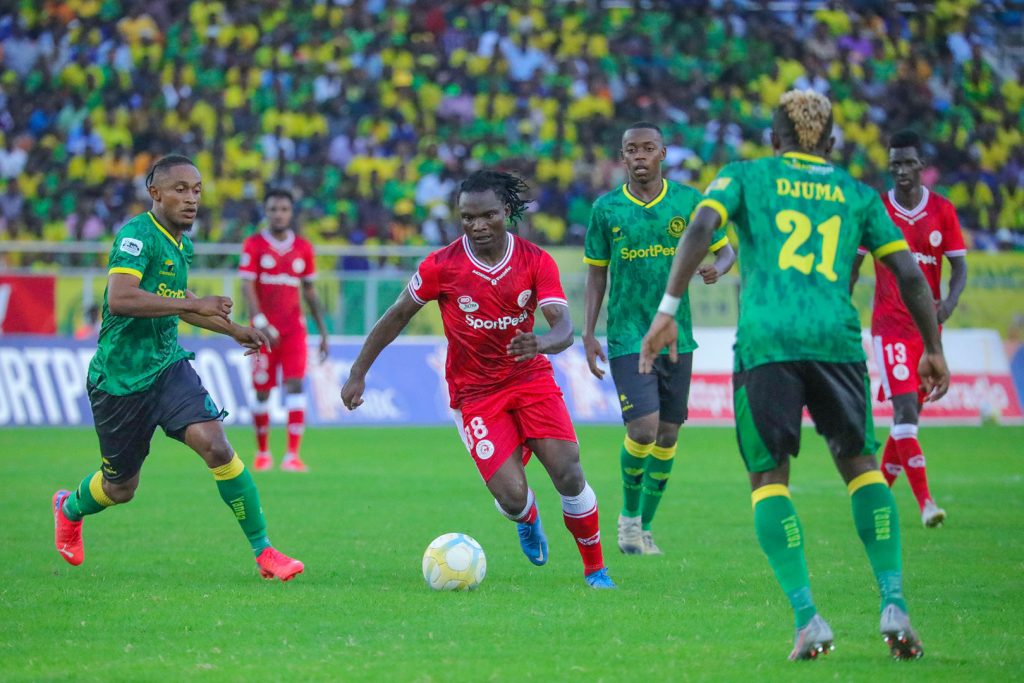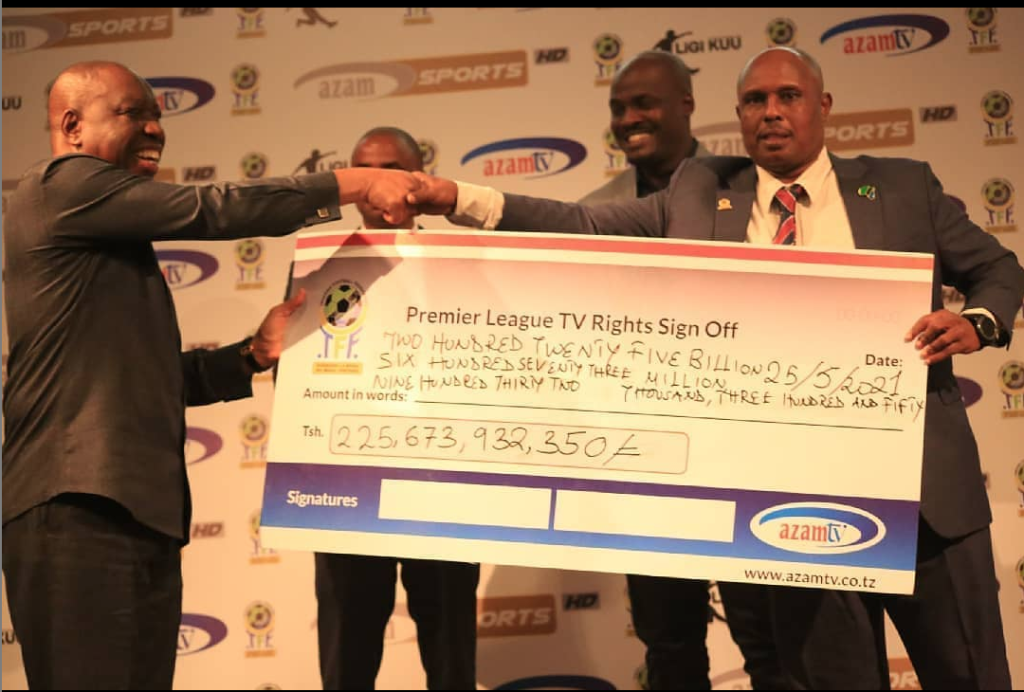When the drone panned out in the dark of night to reveal the sea of red at halftime, Baraka Mpenja of Azam TV blasted: “This is not the Emirates. It is the Benjamin Mkapa Stadium.” Perhaps the ambiance of the 60,000 fans, the loud music, or the occasional howling of hundreds of vuvuzelas overwhelmed him. He is no Peter Drury, but it was equally poetic.
It was on the latest installment of Simba Day- the peak of a long week celebration of Simba and its fans- and Simba had not only sold out the stadium but also graced it with the sheer presence of President Samia. They had a purpose: first, to declare themselves champions of the upcoming season; second, to show Yanga who the ‘animal’ is.
A week earlier, Yanga, the most storied club in the country, had attempted the same feat but came a bit shy. Simba was here to make a mockery out of them, and it did just that. This is how it’s mostly been since the founding of the modern Tanzania Premier League in 1965. The league (currently the NBC Premier League) has always been a two-horse race league. These two giants have culminated in a rivalry that is the league’s story.
The Derby That Changed Tanzanian Soccer
In its 58 years, the two from Kariakoo have been crowned 49 times. Simba 21, times leaving Yanga with the lion’s share. Their rivalry has been intense mockery, full of passion and milestones, love and indifference, laughter and cries, and for the better- successful that it’s among Africa’s top five derbies.
To date, Simba and Yanga command Tanzania’s most extensive fan base. On the day they play each other, the country stops- not just for the 90 minutes of football- but until they meet again. To fans, they are religion.
It is that much power that they have monetized. In the 2022/2023 season, Yanga reported revenue of Sh17.8 billion. On the other hand, Simba posted Sh12 billion in revenue during the 2021/2022 season. But it was not always like this. Teams have been running on losses for much of the league’s history. The days that Yanga asked its fans to bail it out of a financial mess are not far from memory. Mostly, these difficulties were because the league lacked stable sponsors and broadcast partners.
That almost changed in 2008 when British television channel GTV acquired rights to the league for Sh300 million. The contract was to run for four years, but GTV went bankrupt after only four months. The task then- taken out of nationalism- fell on Sahara Media, the mother company of Star TV, Radio Free Africa, and KISS FM. They failed and ended up broadcasting the Simba vs. Yanga fixtures only.
As an alternative resort, the Tanzania Football Federation(TFF) offered SuperSport the rights for free. The idea’s premise was to expose the league to sponsors, but it proved a failure since teams did not receive any revenue, and Super Sports bailed out in 2013 due to low subscriber numbers in Tanzania.
That same year, a newly formed media company from the Bakhresa Group, Azam TV, outbid other companies for the rights with its Sh5.56 billion package that would last three years. The deal was the most giant Tanzanian football had ever seen, but small yet the same for football. In the agreement, individual teams would receive Sh100 million from the zero SuperSport was offering before.
Some critics called the deal ill-advised since Azam had no experience in sports broadcasting. The value even started a rocky start but proved successful. When the agreement ended, TFF renewed the contract in 2016- guaranteeing the league 23 billion for the next five years.
Transforming Tanzania’s Football Landscape
It was in this second Azam era that the league grew exponentially. When Azam acquired the rights, it made it its mission to broadcast every match from any corner of the country.
No African broadcaster could do that for a local league, not even the richer SuperSport. With this, fans could follow their teams all season long without missing any action. On top of that, Azam renewed its infrastructure to broadcast in HD and employed quality analysts to break down the beautiful game.
Its most muscular front, though, was how cheap it was. At only Sh18,000, fans could enjoy all the games. Such a factor only ensured an upward graph trend in a nation whose population is passionate about football.
Slowly, fan attendance at games began improving. As did kit sales and social media interactions. This prompted further lucrative investments; Mo Dewji bought a controlling stake at Simba, Sportspesa entered billion-shilling contracts with Simba and Yanga, and NMB tied itself to Azam FC. These investments changed the game for good.
But Azam was far from being done. In 2021, they reacquired the rights for $100 million. Essentially, this contract is among the five best in Africa and runs for ten years. So far, the warranty has increased investments in the league; NBC signed with TFF, Simba doubled its Sportpesa deal with Mbet, Yanga updated its agreement with GSM, and Singida entered a sponsorship with Sportspesa.
During this tenure, the NBC Premier League became among the world’s top 50 most competitive leagues, as per the International Federation of Football History and Statistics(IFFHs). In Africa, the league has overthrown heavyweights such as Nigeria to rank fifth by index, behind only Egypt, Morocco, Algeria, and Sudan.
This was an easy feat because the previous contract had built an infrastructure good enough to attract foreign-quality players, brought about an influx of academies to nurture local talent, and ensured a diehard fan base.
A Tale of Ratings and Revenue Gaps
Though Azam never releases the ratings of how the league fares in its channels, they should be high since it’s the second most subscribed broadcasting service behind only Startimes, with 862,616 active decoders as of June 2023. Another metric we can use to estimate the league’s growth is the rise in player salaries.
Usually, they are kept under wraps, but Fei Toto’s transfer saga gave us a glimpse of the money players can make. At the end of the drama that spanned months, Feisal was confirmed as an Azam player, where he would earn Sh15 million a month as opposed to the Sh4 million he was getting at Yanga. Those numbers were unthinkable years ago.
We have a reason to celebrate. We have come from so far. However, we also need to acknowledge the league’s shortcomings- particularly the disparity in revenue among the teams. Our company is closer to La Liga than it is to the EPL. More than 90% of kit sales, gate fees, and sponsorship revenue goes to our two giants( Simba and Yanga), while the rest share remnants.
In the end, it’s unbalanced because of this monopoly. Our Atletico Madrid (Azam FC) only seems to be doing fine because an influential investor is backing it.
There is not much AZAM TV can do about that because TV revenue is equally shared and performance-based. But it could, however, introduce geo-blockers for games being played in a particular city. This would force more fans to attend games and purchase kits.
For the subsequent contract signing with Azam or any other broadcaster, I am confident it will be worth more than $25 million a year because, accounting for all metrics in the next eight years, our league can only grow. And for that, we have Azam TV to thank.
Read more articles by Gilbert Anthony.


